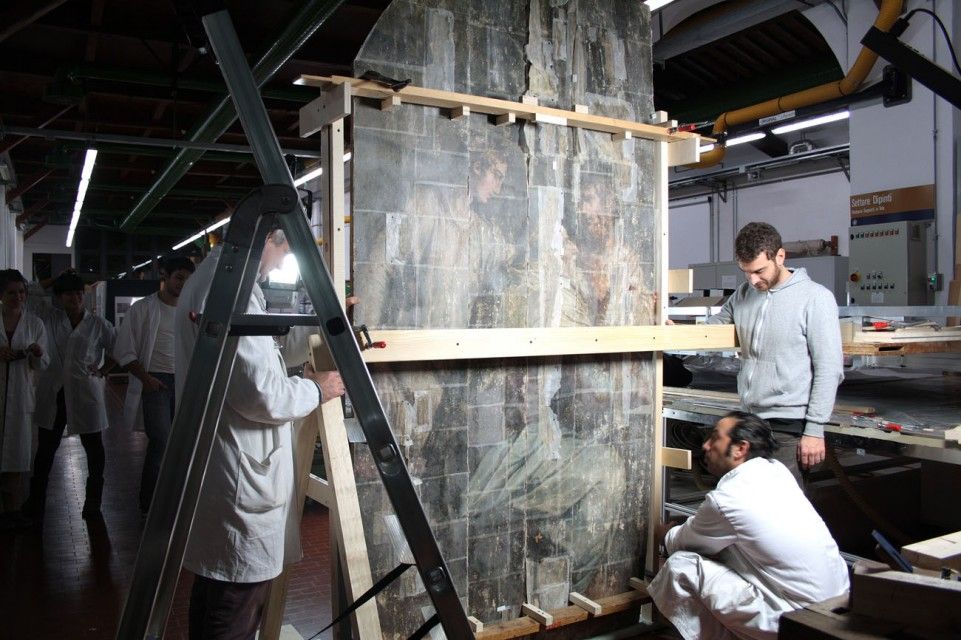Major Renaissance Painting Restored 50 Years After It Was Covered in Flood Waters
Giorgio Vasari’s “Last Supper” was heavily damaged during Florence’s 1966 flood. Conservationists finally figured out how to save it
/https://tf-cmsv2-smithsonianmag-media.s3.amazonaws.com/filer/6f/af/6faf7809-0285-4171-8542-d8c7c04bda88/vasari_full_image.jpg)
Fifty years ago this month, the River Arno, which flows through the center of Florence, Italy, flooded. According to Gaia Pianigiani at The New York Times, the rising waters barreled through the Tuscan city at 45 miles per hour, killing 35 people and knocked out heat and power for 70,000 people. It also inundated the National Library, the Uffizi Gallery and other historic properties housing priceless Renaissance manuscripts, sculptures and paintings.
In the aftermath of the flood, locals and foreign college students waded into the muck to collect the artworks. Dubbed the “mud angels,” they helped gather what was left of the priceless objects. Rossella Lorenzi at Discovery News reports that the recovery effort helped save a huge amount of the collections damaged by mud, water and slime. Over the decades, new restoration techniques helped bring much of the artwork back to near pre-flood condition. But restorers questioned if they could ever save one severely damaged piece. According to Antoine Wilmering at the Getty Museum, the towering, more than 8-feet by 12-feet “Last Supper” completed by Giorgio Vasari in 1546 soaked in a mixture of water, mud and heating oil for more than 12 hours in the museum of Santa Croce Church. Some of the paint began to run down toward the bottom of the image. Restoration experts made a last ditch effort to save the painting and to prevent the pigments from drying and flaking off. They covered “The Last Supper” in a layer of conservation-grade paper, and when that ran out, tissue paper, gluing it to the surface.
They then slowly dried the wooden panels in a humidity-controlled facility to avoid splitting and mold growth. The paper-covered painting was then put in storage, with conservators unsure if it was salvageable or if it would ultimately be a casualty of the flood.
But Lorenzi reports conservators in the late 1960s made the right choice. “We can now say that system has worked. However, the glue used to attach the paper was a very strong acrylic resin which over the decades became an impermeable plate,” Marco Ciatti, head of the restoration center Opificio delle Pietre Dure (OPD), which has spent years restoring the painting, tells Lorenzi.
About a decade ago, Lorenzi reports conservationists discovered a method of removing the paper and resin without damaging the paint, which was the first step in the restoration process.
Wilmering says that in 2010 OPD received a three-year grant from Prada and The Getty Foundation to take the restoration of the painting even further. The first step was to shore up the wooden structure. The water damage had caused cracks and breaks in the poplar wood panels, and the supports on the back was also in poor shape, which meant the painting was in pieces. It took three years to fill the cracks and get the painting back into one piece. Then conservators used synthetic resins to adhere the paint to the panels. “The result is amazing. It went beyond my expectations. Our success is due to innovative products and technologies, but most of all to the dexterity of our restorers,” Ciatti tells Lorenzi.
In the last 50 years, Florence has installed many flood control measures, but there’s no guarantee that a catastrophic flood won’t happen again. That’s why, Wilmering says, the Museum of the Opera of Santa Croce has put “The Last Supper” on a winch system. With the press of a button, the painting will be lifted 20 feet into the air, hopefully out of the way of any rising flood waters.
